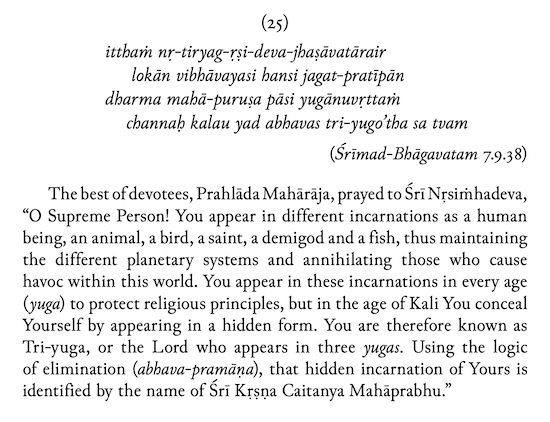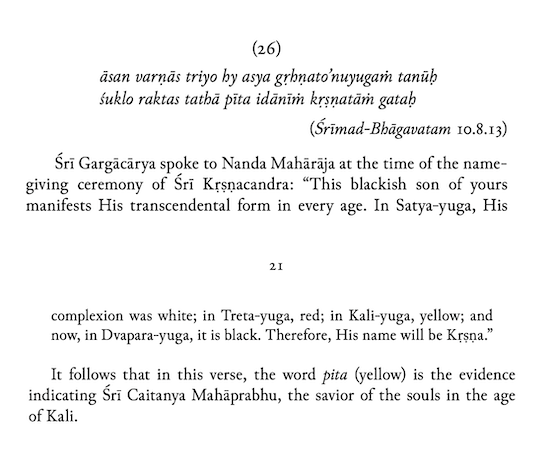Caitanya Mahaprabhu — Scriptural Proofs of His Avatarahood and Divinity. Part 7
 In his commentary on stanzas 11.5.31–32 of the Bhāgavata-purāṇa, Viśvanātha states that the words channaḥ kalau (“hidden in Kali”) imply Caitanya and mean that avatāra-s descend in the age of Kali with a mission different from the missions of avatāra-s in other yuga-s.
The explanations of this verse by thinkers of other schools, including that of Jīva, do not contain any hint of special avatāra-s. According to Śrīdhara, the God in the form of avatāra-s protects worlds by punishing enemies, but he does not do so in the age of Kali, so he is called Triyuga. A commentary attributed to Vijayadhvaja Tīrtha (Dvaita) expresses the same thought: “You protect dharma on the four pillars [truthfulness, compassion, purity and asceticism]. In age of Kali you do not do this [became hidden in kali-yuga], so you are a Triyuga.” Śukadeva of the Nimbārka school in the Siddhānta-pradīpa believes that stanza 7.9.38 is talking about the Buddha. According to Bhagavatprasādācārya of the Vallabha school, channaḥ kalau means that the Lord appears in the age of Kali concealing the six chief possessions (bhāga): knowledge, might, etc. And this echoes one of the meanings of the word “triyuga”: “three by two,” i.e., “six” – “possessing six properties,” where yuga means “two” or “pair” (yugala).
The following conclusion can be drawn from Prabhupāda’s explanation: the God descended in the age of Kali to save the fallen souls, but he conceals his divinity as he might be mistaken for an impostor. Although some intelligent Bengalis and Oriyas, the so-called “companions of Caitanya,” considered him a God, yet he denied it. From Prabhupāda’s point of view, channaḥ kalau is Caitanya’s concealment and denial of his divinity. Only Viśvanātha and Prabhupāda connect stanza 7.9.38 with Caitanya.
After Viśvanātha, 130 years passed. During this time, qualitatively new “prophecies” of Caitanya’s appearance from the Upaniṣads and Purāṇas with more biographical details appeared. While the proposed earlier “prophecies” were just timid attempts to present Caitanya as an avatāra, the new ones became a direct reference to him. Bhaktivinoda’s work falls in the same period. Bhaktivinoda did not skimp on new dogmas, interpretations and revelations.
In his commentary on stanzas 11.5.31–32 of the Bhāgavata-purāṇa, Viśvanātha states that the words channaḥ kalau (“hidden in Kali”) imply Caitanya and mean that avatāra-s descend in the age of Kali with a mission different from the missions of avatāra-s in other yuga-s.
The explanations of this verse by thinkers of other schools, including that of Jīva, do not contain any hint of special avatāra-s. According to Śrīdhara, the God in the form of avatāra-s protects worlds by punishing enemies, but he does not do so in the age of Kali, so he is called Triyuga. A commentary attributed to Vijayadhvaja Tīrtha (Dvaita) expresses the same thought: “You protect dharma on the four pillars [truthfulness, compassion, purity and asceticism]. In age of Kali you do not do this [became hidden in kali-yuga], so you are a Triyuga.” Śukadeva of the Nimbārka school in the Siddhānta-pradīpa believes that stanza 7.9.38 is talking about the Buddha. According to Bhagavatprasādācārya of the Vallabha school, channaḥ kalau means that the Lord appears in the age of Kali concealing the six chief possessions (bhāga): knowledge, might, etc. And this echoes one of the meanings of the word “triyuga”: “three by two,” i.e., “six” – “possessing six properties,” where yuga means “two” or “pair” (yugala).
The following conclusion can be drawn from Prabhupāda’s explanation: the God descended in the age of Kali to save the fallen souls, but he conceals his divinity as he might be mistaken for an impostor. Although some intelligent Bengalis and Oriyas, the so-called “companions of Caitanya,” considered him a God, yet he denied it. From Prabhupāda’s point of view, channaḥ kalau is Caitanya’s concealment and denial of his divinity. Only Viśvanātha and Prabhupāda connect stanza 7.9.38 with Caitanya.
After Viśvanātha, 130 years passed. During this time, qualitatively new “prophecies” of Caitanya’s appearance from the Upaniṣads and Purāṇas with more biographical details appeared. While the proposed earlier “prophecies” were just timid attempts to present Caitanya as an avatāra, the new ones became a direct reference to him. Bhaktivinoda’s work falls in the same period. Bhaktivinoda did not skimp on new dogmas, interpretations and revelations.
 If we turn to the words of the Bhāgavata-purāṇa 10.8.13, rather than Nārāyaṇa Mahārāja’s translation, we see a very different picture:
“[He — Kṛṣṇa] was already of three colours, incarnating through the ages: his body was white, red, then yellow/green, [and] now [it is] black.”
Garga Muni states that in the age of Dvapara the Lord’s body was green (pīta), but now it is black in colour. In place of the colour of śyāma (11.5.27, description of the God in the dvāpara-yuga), Garga has the colour of pīta. Karabhājana describes the colour of God by yuga in the following order: śukla, rakta, śyāma, kṛṣṇa.
In the avatarology of the International Society for Krishna Consciousness, the dvāpara-yuga-avatāra is considered to be Kṛṣṇa. In support of this idea they quote stanza 11.5.27 of the Bhāgavata-purāṇa, but the name of the avatāra is not mentioned in the stanza itself, and the word “avatāra” is also absent. The conclusion that the dvāpara-yuga-avatāra is Kṛṣṇa is drawn by the presence of the colour śyāma in the stanza, traditionally considered to be the colour of Kṛṣṇa. Here the colour śyāma is “dark” or “black”. In the translation of stanza 11.5.27 and in his commentary on it, Prabhupāda writes (see commentary on the Caitanya-caritāmṛta 2.20.337):
“In Dvāpara-yuga the Personality of Godhead appears in a blackish hue. He is dressed in yellow, He holds His own weapons, and He is decorated with the Kaustubha jewel and the mark of Śrīvatsa. That is how His symptoms are described… The śyāma color is not exactly blackish. Śrīla Bhaktisiddhānta Sarasvatī Ṭhākura compares it to the color of the atasī flower. It is not that Lord Kṛṣṇa Himself appears in a blackish color in all the Dvāpara-yugas. In other Dvāpara-yugas, previous to Lord Kṛṣṇa’s appearance, the Supreme Lord appeared in a greenish body by His own personal expansion. This is mentioned in the Viṣṇu Purāṇa, Hari-vaṁśa and Mahābhārata.”
According to the Bhāgavatam, the body of the Lord in the dvāpara-yuga is of the colour śyāma, and the words of Garga (10.8.13) are about Kṛṣṇa, the newborn son of Vasudeva, being of a dark colour (kṛṣṇa). In stanza 11.5.27 it is said that the lord of the colour śyāma was already worshipped in the dvāpara-yuga. “Already” means “before Kṛṣṇa’s birth” (see Prabhupāda’s translation and commentary on the Caitanya-caritāmṛta 2.20.337), and Garga’s words (10.8.13) refer to Kṛṣṇa, the newborn dark-coloured son of Vasudeva, born at the very end of the dvāpara-yuga. The Garga lists the colours in the following order: śukla (kṛta-yuga), rakta (tretā-yuga), pīta (dvāpara-yuga), kṛṣṇa (kali-yuga). If the avatarology of the International Society for Krishna Consciousness is correct and Kṛṣṇa is considered the dvāpara-yuga-avatāra, then to whom does the yellow-green colour pīta mentioned by Garga refer if, according to Prabhupāda, in dvāpara-yuga the Lord is dark-coloured (śyāma)?
If we turn to the words of the Bhāgavata-purāṇa 10.8.13, rather than Nārāyaṇa Mahārāja’s translation, we see a very different picture:
“[He — Kṛṣṇa] was already of three colours, incarnating through the ages: his body was white, red, then yellow/green, [and] now [it is] black.”
Garga Muni states that in the age of Dvapara the Lord’s body was green (pīta), but now it is black in colour. In place of the colour of śyāma (11.5.27, description of the God in the dvāpara-yuga), Garga has the colour of pīta. Karabhājana describes the colour of God by yuga in the following order: śukla, rakta, śyāma, kṛṣṇa.
In the avatarology of the International Society for Krishna Consciousness, the dvāpara-yuga-avatāra is considered to be Kṛṣṇa. In support of this idea they quote stanza 11.5.27 of the Bhāgavata-purāṇa, but the name of the avatāra is not mentioned in the stanza itself, and the word “avatāra” is also absent. The conclusion that the dvāpara-yuga-avatāra is Kṛṣṇa is drawn by the presence of the colour śyāma in the stanza, traditionally considered to be the colour of Kṛṣṇa. Here the colour śyāma is “dark” or “black”. In the translation of stanza 11.5.27 and in his commentary on it, Prabhupāda writes (see commentary on the Caitanya-caritāmṛta 2.20.337):
“In Dvāpara-yuga the Personality of Godhead appears in a blackish hue. He is dressed in yellow, He holds His own weapons, and He is decorated with the Kaustubha jewel and the mark of Śrīvatsa. That is how His symptoms are described… The śyāma color is not exactly blackish. Śrīla Bhaktisiddhānta Sarasvatī Ṭhākura compares it to the color of the atasī flower. It is not that Lord Kṛṣṇa Himself appears in a blackish color in all the Dvāpara-yugas. In other Dvāpara-yugas, previous to Lord Kṛṣṇa’s appearance, the Supreme Lord appeared in a greenish body by His own personal expansion. This is mentioned in the Viṣṇu Purāṇa, Hari-vaṁśa and Mahābhārata.”
According to the Bhāgavatam, the body of the Lord in the dvāpara-yuga is of the colour śyāma, and the words of Garga (10.8.13) are about Kṛṣṇa, the newborn son of Vasudeva, being of a dark colour (kṛṣṇa). In stanza 11.5.27 it is said that the lord of the colour śyāma was already worshipped in the dvāpara-yuga. “Already” means “before Kṛṣṇa’s birth” (see Prabhupāda’s translation and commentary on the Caitanya-caritāmṛta 2.20.337), and Garga’s words (10.8.13) refer to Kṛṣṇa, the newborn dark-coloured son of Vasudeva, born at the very end of the dvāpara-yuga. The Garga lists the colours in the following order: śukla (kṛta-yuga), rakta (tretā-yuga), pīta (dvāpara-yuga), kṛṣṇa (kali-yuga). If the avatarology of the International Society for Krishna Consciousness is correct and Kṛṣṇa is considered the dvāpara-yuga-avatāra, then to whom does the yellow-green colour pīta mentioned by Garga refer if, according to Prabhupāda, in dvāpara-yuga the Lord is dark-coloured (śyāma)?

